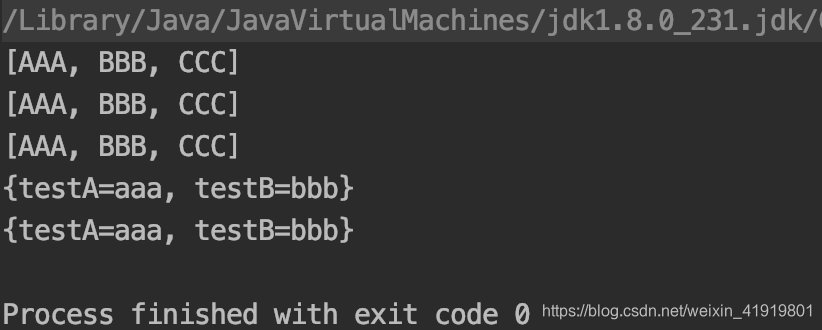依赖注入的概念
- 依赖注入:Dependency Injection。它是 spring 框架核心IOC的具体实现。
- IOC的作用:降低程序中的耦合(依赖关系),但是绝不可能消除。
我们的程序在编写时,通过控制反转,把对象的创建交给了 spring,但是代码中不可能出现没有依赖的情况。例如:我们的业务层仍会调用持久层的方法。这种业务层和持久层的依赖关系,在使用 spring 之后,就让 spring 来维护了。
简单的说,就是坐等框架把持久层对象传入业务层,而不用我们自己去获取。
注入数据的类型
有三类:
- 基本数据类型和String
- 其他bean类型(在配置文件或者注解中配置过得bean)
- 复杂类型/集合类型
一、构造函数注入
编写业务层实现类的构造函数
/**
1. 账户的业务层实现类
*/
public class AccountServiceImpl implements IAccountService {
//private IAccountDao accountDao = new AccountDaoImpl();
private String name;
private Integer age;
private Date birthday;
public AccountServiceImpl(String name, Integer age, Date birthday) {
this.name = name;
this.age = age;
this.birthday = birthday;
}
@Override
public void saveAccount(){
System.out.println(name +"\n"+ age +"\n"+ birthday);
}
}
在bean.xml中注入数据
使用构造函数的方式,给 service 中的属性传值
要求:
- 类中需要提供一个对应参数列表的构造函数。
- 涉及的标签:constructor-arg
属性:
- 给谁赋值:
- index:指定参数在构造函数参数列表的索引位置
- type:指定参数在构造函数中的数据类型
- name:指定参数在构造函数中的名称,用这个找给谁赋值
- 赋什么值:
- value:它能赋的值是基本数据类型和 String 类型
- ref:它能赋的值是其他 bean 类型,也就是说,必须得是在配置文件中配置过的 bean
<?xml version="1.0" encoding="UTF-8"?>
<beans xmlns="http://www.springframework.org/schema/beans"
xmlns:xsi="http://www.w3.org/2001/XMLSchema-instance"
xsi:schemaLocation="http://www.springframework.org/schema/beans
http://www.springframework.org/schema/beans/spring-beans.xsd">
<bean id="accountServer" class="com.java.service.impl.AccountServiceImpl">
<constructor-arg name="name" index="0" value="张三"></constructor-arg>
<constructor-arg name="age" index="1" value="18"></constructor-arg>
<constructor-arg name="birthday" index="2" ref="time"></constructor-arg>
</bean>
<bean id="time" class="java.util.Date"></bean>
这里有一个注意的点:birthday是Date类型的数据,而value属性中的值默认是字符串,因此这里不能直接写时间,而应该使用ref关联一个配置过的bean来表示时间。
测试
/**
* 模拟一个表现层,用于调用业务层
*/
public class Client {
public static void main(String[] args) {
//1、获取容器对象
ApplicationContext ac = new ClassPathXmlApplicationContext("bean.xml");
//2、根据id获取Bean对象
IAccountService as = (IAccountService)ac.getBean("accountServer");
IAccountDao ad = ac.getBean("accountDao",IAccountDao.class);
as.saveAccount();
//as.saveAccount();
}
}
运行结果:

使用构造函数注入的优劣:
- 优势:在获取bean对象时,注入数据是必须的操作,否则无法创建对象
- 弊端:改变了bean对象的实例化方法,当创建对象时,即使用不到这些数据,也必须提供。
二、set方法注入
生成业务层实现类的Setter方法
/**
* 账户的业务层实现类
*/
public class AccountServiceImpl implements IAccountService {
private String name;
private Integer age;
private Date birthday;
public void setName(String name) {
this.name = name;
}
public void setAge(Integer age) {
this.age = age;
}
public void setBirthday(Date birthday) {
this.birthday = birthday;
}
@Override
public void saveAccount(){
System.out.println(name +"\n"+ age +"\n"+ birthday);
}
}
在bean.xml中注入数据
通过配置文件给 bean 中的属性传值:使用 set 方法的方式
涉及的标签:property
属性:
- name:找的是类中 set 方法后面的部分
- ref:给属性赋值是其他 bean 类型的
- value:给属性赋值是基本数据类型和 string 类型的
使用Set方法注入的优劣: - 优势:创建对象时没有明确的限制,可以直接使用默认构造函数
- 弊端:当某个对象必须有值,在获取对象时有可能出现set方法没有执行的情况
<?xml version="1.0" encoding="UTF-8"?>
<beans xmlns="http://www.springframework.org/schema/beans"
xmlns:xsi="http://www.w3.org/2001/XMLSchema-instance"
xsi:schemaLocation="http://www.springframework.org/schema/beans
http://www.springframework.org/schema/beans/spring-beans.xsd">
<bean id="accountServer" class="com.itheima.service.impl.AccountServiceImpl">
<property name="name" value="李四"></property>
<property name="age" value="19"></property>
<property name="birthday" ref="time"></property>
</bean>
<bean id="time" class="java.util.Date"></bean>
</beans>
测试
原先的表现层代码原封不动,运行结果如下:

三、复杂类型/集合类型注入
编写业务层实现类的复杂类型和集合类型,生成set方法
/**
* 账户的业务层实现类
*/
public class AccountServiceImpl implements IAccountService {
private String[] myStrs;
private List<String> myList;
private Set<String> mySet;
private Map<String,String> myMap;
private Properties myProps;
public void setMyStrs(String[] myStrs) {
this.myStrs = myStrs;
}
public void setMyList(List<String> myList) {
this.myList = myList;
}
public void setMySet(Set<String> mySet) {
this.mySet = mySet;
}
public void setMyMap(Map<String, String> myMap) {
this.myMap = myMap;
}
public void setMyProps(Properties myProps) {
this.myProps = myProps;
}
@Override
public void saveAccount(){
System.out.println(Arrays.toString(myStrs));
System.out.println(myList);
System.out.println(mySet);
System.out.println(myMap);
System.out.println(myProps);
}
}
在bean.xml中注入数据
- List 结构的:
array,list,set - Map 结构的
map,entry,props,prop
<?xml version="1.0" encoding="UTF-8"?>
<beans xmlns="http://www.springframework.org/schema/beans"
xmlns:xsi="http://www.w3.org/2001/XMLSchema-instance"
xsi:schemaLocation="http://www.springframework.org/schema/beans
http://www.springframework.org/schema/beans/spring-beans.xsd">
<bean id="accountServer" class="com.itheima.service.impl.AccountServiceImpl">
<!-- 在注入集合数据时,只要结构相同,标签可以互换 -->
<!-- 给数组注入数据 -->
<property name="myStrs">
<set>
<value>AAA</value>
<value>BBB</value>
<value>CCC</value>
</set>
</property>
<!-- 注入 list 集合数据 -->
<property name="myList">
<array>
<value>AAA</value>
<value>BBB</value>
<value>CCC</value>
</array>
</property>
<!-- 注入 set 集合数据 -->
<property name="mySet">
<list><value>AAA</value> <value>BBB</value> <value>CCC</value>
</list>
</property>
<!-- 注入 Map 数据 -->
<property name="myMap">
<props>
<prop key="testA">aaa</prop>
<prop key="testB">bbb</prop>
</props>
</property>
<!-- 注入 properties 数据 -->
<property name="myProps">
<map>
<entry key="testA" value="aaa"></entry>
<entry key="testB">
<value>bbb</value>
</entry>
</map>
</property>
</bean>
</beans>
测试
原先的表现层代码原封不动,运行结果如下:

本文结束。








 本文深入讲解Spring框架中的依赖注入概念,包括三种主要的注入方式:构造函数注入、setter方法注入和复杂类型/集合类型注入。并通过示例代码详细解析每种注入方式的使用场景和优缺点。
本文深入讲解Spring框架中的依赖注入概念,包括三种主要的注入方式:构造函数注入、setter方法注入和复杂类型/集合类型注入。并通过示例代码详细解析每种注入方式的使用场景和优缺点。

















 被折叠的 条评论
为什么被折叠?
被折叠的 条评论
为什么被折叠?








